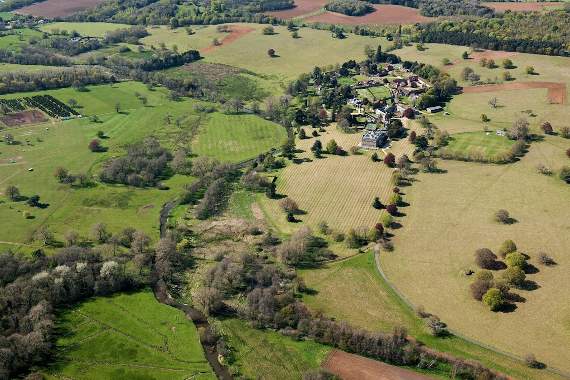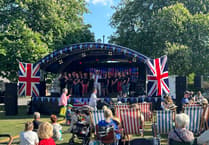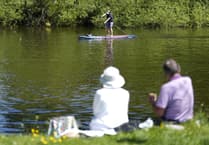PEPER Harow Park, near Godalming, is one of two new Capability Brown landscapes that have been added to the National Heritage List by Historic England celebrating the 300th year since his birth.
Along with Stoke Place in Buckinghamshire, Peper Harow has been added to the list of protected landscapes, along with seven other sites re-listed to celebrate designer’s national importance.
Lancelot “Capability” Brown (c.1716-1783), England’s leading and most influential landscape designer of the 18th century, was responsible for moulding large swathes of English parks into sweeping views and picturesque lakes, and his landscapes are reckoned among the country’s most important contributions to European civilisation.
Brown dominated his profession and was prolific – his work is everywhere - so naturalistic was his approach that many of the parks affected by his design are often mistaken for landscapes untouched by the hand of man.
Historic England says by adding the parks and gardens to the list, it hopes to increase awareness of their historic value and encourage everyone to treat these special places with due care.
Peper Harow Park was landscaped by Brown in the 1760s to emphasise the grandeur of the near-contemporary Grade I listed Peper Harow House designed by eminent architect Sir William Chambers.
Today, Peper Harow Park still largely reflects the original design Brown intended and several trees survive from Brown’s time, which are now over 250 years old. Particularly notable are the Lebanon Cedar.
It is likely Brown was responsible for “sculpting” the River Wey here so as to enhance the natural topography and enhance the principal view from the house.
The park is also home to a cricket pitch which held one of the first ever recorded cricket games in 1727.
The house was owned by the Midleton family until 1944 when it was sold becoming a school and later converted into flats.
Heritage Minister Tracey Crouch said: "Capability Brown was a pioneer in landscape design, whose stunning work is still revered 300 years on at beautiful locations throughout the country. I’m delighted two of his landscapes have been added to the National Heritage List for England, ensuring that these stunning scenes continue to be recognised for centuries to come."
Historic England’s director of listing Dr Roger Bowdler, said: “Lancelot Brown was one of the great creative forces of Georgian England. Steeped in the practicalities of garden design, he brought a lyrical eye to the landscape and envisioned how nature could be improved upon.
“Historic England is delighted to be part of the Capability Brown Festival, and proud to help protect even more of his wonderful parks.”
A new online map created by Historic England, a partner of the Capability Brown Festival, was launched last Friday. It shows the principal Capability Brown landscapes in England and allows you to explore the sites from a bird’s eye view, via new aerial photography. It also connects them to the list, showing which areas and buildings are protected.
Capability Brown Festival director Ceryl Evans said: “It is a fitting tribute, in this 300th year since Brown’s birth, that his legacy is celebrated with the addition of two landscapes to the list and the re-listing of seven other sites.
“People have been enjoying Brown’s quintessential British landscapes for hundreds of years, and now, with this special status, the sites will be protected for generations to come. The creation of an aerial map also means people can view Brown’s landscapes, including those not normally open to the public, from a very different perspective.”
Among other on the list, Wilderness House at Hampton Court Palace has been upgraded to grade II* to reflect its importance as the home of Capability Brown during his time as master gardener to George III.
Wilderness House dates back to around 1700 and is largely unchanged within - a rare survival. Brown is credited with planting the Great Vine at Hampton Court in 1768, the largest grape vine in the world.
The Wotton Underwood landscape in Buckinghamshire has been upgraded to grade I to celebrate it as an outstanding example of an 18th century country house landscape.
The landscape was shaped by a number of high-profile designers of the day, including Capability Brown.
Home to the separately listed grade I house the grounds are full of man-made picturesque details including a large lake, islands, bridges, a rotunda, pavilion and grotto.
Brown’s final resting place is the churchyard of grade I listed St Peter and St Paul church at Fenstanton, in Cambridgeshire, where he was buried in February 1783.
The exceptional medieval church has been re-listed to recognise its connection to the great designer who became Lord of the Manor of Fenstanton when he acquired the manor house from the Earl of Northampton, a mark of his worldly success.
The walled garden at Charlton Park, in Wiltshire, was first listed in 1951. Since then further research has shown that it is highly likely to be a design by Brown, who visited Charlton Park in 1786 and proposed a new walled garden.
Other sites re-listed to celebrate Brown’s national importance include Hewell Grange, in Worcestershire, Temple Newsam, in Leeds, and Appuldurcombe, on the Isle of Wight.
Historic England is also publishing a new book on the famed landscape designer, written by leading Brown authority, John Phibbs.
Place-making: The art of Capability Brown will reveal the thinking behind Brown’s genius and how he shaped our idea of the English designed landscape.
Historic England has joined forces with crowd-funding publisher Unbound to produce this celebration of Brown’s work.
There is still time to pledge your support before the book is due to be published in November.
Visit unbound.com/books/capability-brown to find out more and pledge your support.
The Capability Brown Festival unites 21 partner organisations in the UK’s largest festival of its kind to date. It is managed by the Landscape Institute and is funded with a £911,100 grant from the Heritage Lottery Fund.
Many Brown sites, including those not normally open to the public, have been hosting special events, tours and activities in 2016.





Comments
This article has no comments yet. Be the first to leave a comment.